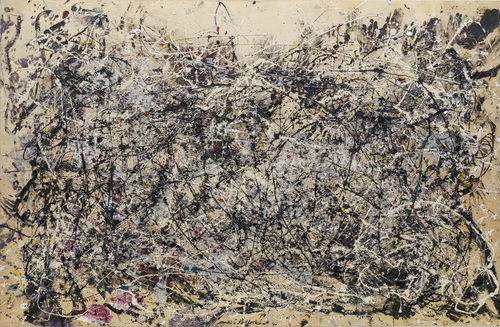It is a common and reassuring saying that beauty is in the eye of the beholder, but does this actually hold up or is it simply a cliche told to make people feel better about themselves? As much as the lay person would like to believe this light and happy little saying, it may not hold as much weight as one would like to think. Yes, there are certainly instances in which one person or group of people agree that something is “beautiful”, or here we’ll say aesthetically pleasing, while another person or group of people will think just the opposite. Some people find a Jackson Pollock (A) to be most aesthetically pleasing while others prefer a Kenneth Noland (B). These are two very different artist and in some cases polarizing artists, which would lead you to believe that beauty can be subjective. Some viewers find the clean lines of Noland to be beautiful, while others find it mundane and ineffectual. In the same way, some viewers see the seeming chaos of a Pollock as clutter and mess, while others find it to be a work of beauty. This is not to say that if a person likes one, the do not like the other, but rather that each painting respectively has fans and critics.
A perfect nonart example of this which most everyone has encountered at some point or another is attraction, who a person find to be beautiful or aesthetically pleasing. Every good friend has quietly recited to quote above or even “everything has beauty but not everyone sees it” as they met a friend’s new significant other. They remind themselves that though they do not see the beauty in a person does not mean that someone else must share their views. This idea of taste can be applied to many things from significant others to room decor to a number of other practical everyday things.
However, as much as we’d like to think that beauty is subjective, there are plenty of theories out there that suggest otherwise. For example, there are theories such as that of the golden ratios that say that certain ratios are more pleasing to the eye than others. This can be applied to simple geometric shapes, the length of fingers, and the proportions of a person’s face. This theory of golden ratios is rooted in mathematical calculations, but in the end is meant to prove to be more aesthetically pleasing to the eye. In the same sense, there are certain colors that are more pleasing than others. Green, for example, is a color that is easier on the eye and therefore apparently more aesthetically pleasing. That being said, I think that in some ways, beauty can be a real property of objects, but in other ways, there is a very subjective nature beyond the aesthetically pleasing in which we find certain things beautiful.
A)  B)
B) 
No comments:
Post a Comment